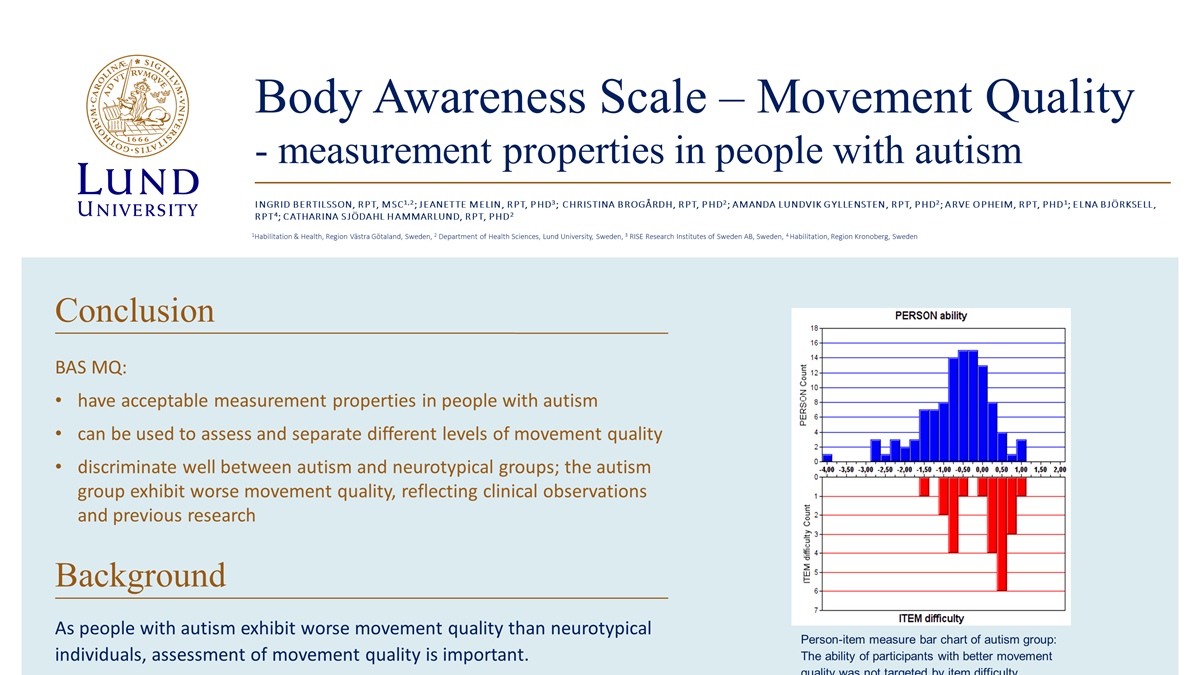Ingrid Bertilsson, doktorand

Kort om Ingrid
Arbete: fysioterapeut vid Habilitering Skövde
Universitetsanknytning: Lunds universitet
Body Awareness Scale – Movement Quality- measurement properties in people with autism
Conclusion
BAS MQ:
- have acceptable measurement properties in people with autism
- can be used to assess and separate different levels of movement quality
- discriminate well between autism and neurotypical groups; the autism group exhibit worse movement quality, reflecting clinical observations and previous research
Background
As people with autism exhibit worse movement quality than neurotypical individuals, assessment of movement quality is important.
Objective
The objective was to assess measurement properties of the Body Awareness Scale Movement Quality (BAS MQ) in people with autism.
Method
Participants were assessed with BAS MQ and included those with autism (n=108) and neurotypical reference group members (n=32), all 15-30 years.
Data were analyzed according to the Rasch model concerning nine properties:
Results
- Targeting was negatively skewed.
- In response category functioning, not all response categories were used in eleven out of 23 items.
- Unidimensionality showed moderate correlation between clusters.
- Fit statistics of items fitted the model well.
- Local dependencies were present for 17 of 253 (7%) of the item residual correlations.
- The hierarchical ordering of items showed coherence with clinical findings.
- Person reliability was good (0.85), enabling a fair separation (2.41). Item reliability was excellent (0.95) with a very good separation (4.57).
- There was a significant differential item functioning in three items, when comparing gender in the autism group.
- Discriminative validity showed significant difference of person measures between the autism and the reference groups (p<0.000).
Within the autism group, there was no significant difference between the three different diagnoses.
Person-item measure bar chart of autism group: The ability of participants with better movement quality was not targeted by item difficulty.
Item difficulty may be seen to the left of the logit scale, and the ability levels of four groups of participants to the right.
Discussion
BAS MQ showed unidimensionality. The results was coherent with clinical findings.
Negatively skewed targeting is relevant in a sample with several participants with good movement quality.
Response category functioning may be improved by further work on the items.
No local dependency was found.
To possibly discriminate any subgroups within the autism group, a larger sample is needed.
Ingrid Bertilsson, RPT, MsC1,2; Jeanette Melin, RPT, PhD3; Christina Brogårdh, RPT, PhD2; Amanda Lundvik Gyllensten, RPT, PhD2; Arve Opheim, RPT, PhD1; Elna Björksell, RPT4; Catharina Sjödahl Hammarlund, RPT, PhD2
1Habilitation & Health, Region Västra Götaland, Sweden, 2Department of Health Sciences, Lund University, Sweden, 3RISE Research Institutes of Sweden AB, Sweden, 4Habilitation, Region Kronoberg, Sweden